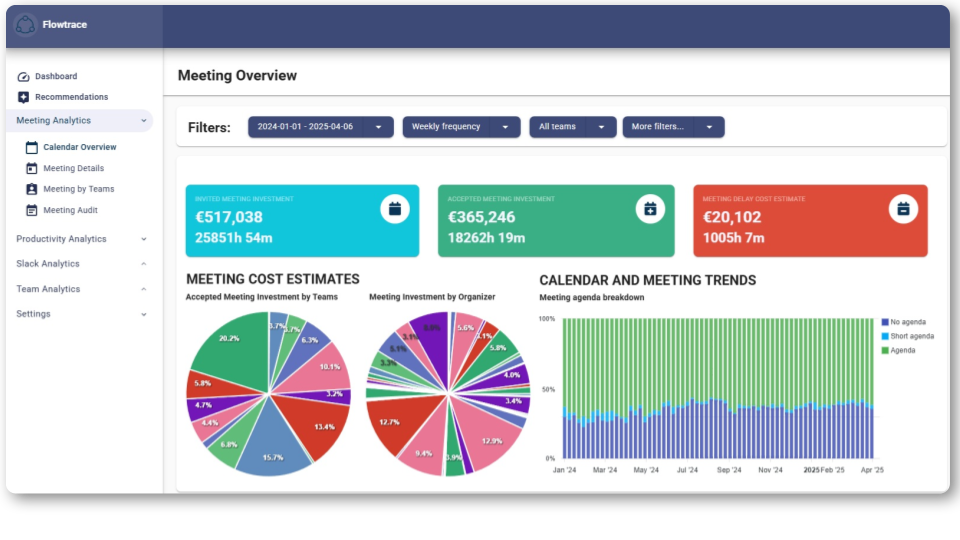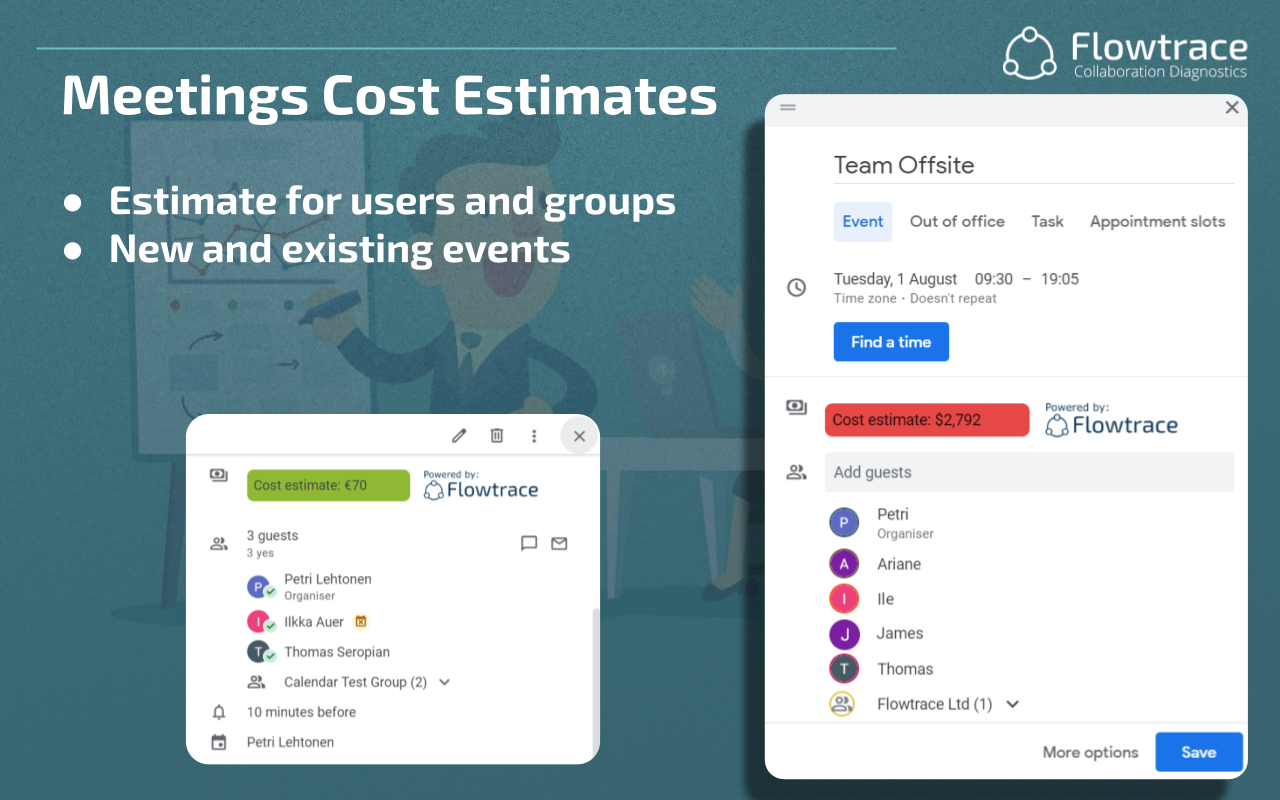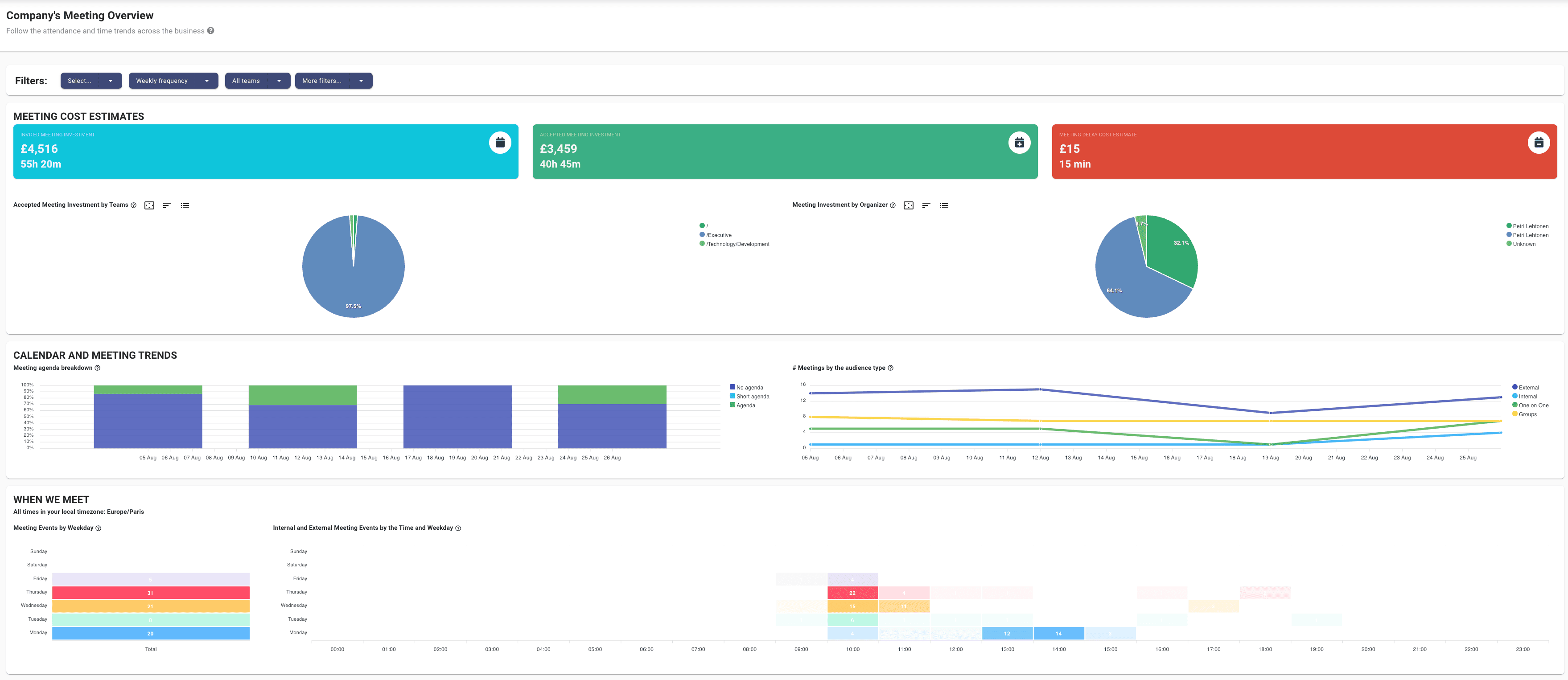Most companies don’t set out with a clear strategy for how meetings should work. They start small, layer on new cadences as teams grow, and gradually build a calendar culture without ever defining it. Over time, the result is predictable: bloated agendas, too many attendees, default hour-long slots, and a growing sense that meetings are taking more than they give.
That’s why real meeting transformation isn’t about shaving a few minutes off every invite, it’s a mindset shift. It requires rethinking how your organization values time, how decisions are made, and how collaboration happens. It means turning meetings from a passive habit into an intentional system.
This article walks through that transformation. First, by showing you how to understand the meeting reality you’re working with. Then, how to define what good looks like for your team. And finally, how to put structure and tools in place, like Flowtrace, to make lasting change possible. Because changing meeting behavior takes time, and with the right data and systems, you can do it methodically, not reactively.

Map the Reality: Why Transformation Starts with Clarity
Before you can change how your organization meets, you need to understand how it's meeting today. Most meeting problems, overbooking, low engagement, long durations, and unclear outcomes, are easy to feel but hard to quantify. They’re symptoms of deeper patterns that only become visible when you start measuring them.
According to the Microsoft 2023 Work Trend Index, the average employee spends more than 25% of their week in meetings, and many say they’re ineffective or unnecessary. But without real meeting analytics, it’s difficult to know where that time is going—or why it’s not producing better outcomes.
That’s why real meeting transformation starts with clarity.
Flowtrace automatically surfaces the data that reveals what’s actually happening in your meeting culture:

- Meeting load by role or team – See who’s overloaded, under-scheduled, or out of balance
- Duration breakdowns – Spot whether default slots are being used productively or just by habit
- Agenda presence – Understand how often meetings are structured vs. improvised
- Delay trends – Identify where lateness is creating calendar ripple effects
- Invitee patterns – Track who’s being invited, who’s optional, and where over-invitation is happening
- Meeting cost visibility – See the real-time financial impact of meetings based on attendee roles and duration
These insights replace assumptions with hard data, so you're not relying on hunches or scattered feedback to guide change. You can’t transform what you can’t measure. Flowtrace gives you the visibility to face the facts and make decisions with confidence.
Define What Transformation Looks Like for Your Team
Once you’ve surfaced the data, the next step is deciding what kind of meeting culture you actually want to build. There’s no one-size-fits-all blueprint, your company’s ideal meeting environment depends on your goals, team structure, and ways of working.
But the key is this: transformation doesn’t just mean fewer meetings, it means more intentional ones.
Start by asking fundamental questions:
- What kinds of meetings should we have more—or less—of?
- How do we protect time for deep work and reduce context-switching?
- Who actually needs to be in the room for decisions to happen?
- What should our total meeting load cost in time and budget per week?
These questions lead to internal principles that define your version of better:
- “No recurring meeting without a quarterly review.”
- “Agendas required for all meetings over 15 minutes.”
- “Async preferred for status updates or non-urgent alignment.”
When companies take this intentional approach, the impact is real. A study by MIT Sloan found that organizations that implemented meeting design policies, such as requiring agendas and capping durations, saw a 42% increase in team productivity and reclaimed up to 18% of the workweek for focused work.
These principles don’t need to be complex, but they do need to be clear, consistent, and visible. Without alignment, change will be uneven and short-lived. It’s about designing a better system that supports your goals, and making sure everyone knows what “good” looks like.
Put Structure Behind the Vision with Flowtrace Tools
Defining your meeting principles is an important step, but without tools to support them, those principles will remain aspirational. Real change happens when new behaviors are reinforced consistently, at the point where meetings are actually scheduled and run.
That’s where Flowtrace comes in. It takes your vision for better meetings and embeds it directly into your team’s daily workflows through seamless calendar-native integrations with Google and Outlook.
Make meeting policies part of the process

Flowtrace allows you to add meeting policies where they matter most, inside the calendar:
- Set default durations to 25 or 50 minutes to break the 30/60-minute cycle
- Require agendas before a meeting invite can be completed
- Cap or flag large attendee lists, helping organizers rethink invite strategy
- Trigger smart suggestions when policies are not being followed
These interventions don’t add friction, they provide guidance right when it’s needed.
Surface cost and behavior insights in real time

When someone books a meeting, Flowtrace provides real-time cost overlays based on invitees and meeting length. This makes the financial impact of meetings visible up front, changing how people think about the time they’re booking.
- Cost prompts help teams reduce unnecessary meetings or attendee counts
- Delay risk alerts flag recurring lateness and help reduce calendar ripple effects
- In-calendar nudges remind users to align with company meeting standards
It’s not about control, it’s about building awareness and enabling better decisions.
Track policy adoption and progress

To sustain change, you need to know what’s improving and where support is still needed. Flowtrace provides dashboards at both the team and individual level to show:
- Policy compliance over time
- Meeting cost trends
- Agenda usage rates
- Attendance and invitation patterns
These insights allow you to coach where needed, highlight positive trends, and keep your transformation moving forward. Flowtrace doesn’t just show you what’s wrong, it builds the infrastructure to help everyone do meetings better, automatically.
Treat Transformation as an Ongoing Process
Meeting transformation doesn’t happen overnight, and it rarely follows a straight line. Even with strong principles and the right tools, old habits resurface, priorities shift, and teams need to recalibrate. That’s why transformation must be treated as a continuous process, not a one-off initiative.
With Flowtrace, you gain the visibility and flexibility to monitor progress, spot regression early, and adjust in real time.
Use data to steer the process

Flowtrace gives you the insight to go beyond surface-level impressions and track how meeting behavior evolves over time. You can:
- Review trends monthly to see whether meeting volume, cost, or quality is improving
- Spot early warning signs like declining agenda usage or rising delay times
- Identify teams that need support, based on compliance rates or meeting load
- Iterate on policies based on what’s working, and what isn’t
When the data is visible and up-to-date, you’re not left guessing. You can make precise adjustments that keep your culture moving in the right direction.
Reinforce the human side of change
Tools and policies are essential, but changing how people plan, run, and attend meetings takes repetition. Habits form slowly, and they only stick when people see that their efforts are making a difference.
Flowtrace helps make that progress visible:
- Dashboards show where positive shifts are happening
- Teams can compare their performance over time
- Individuals can track their own improvement and make informed changes
By treating meeting transformation as a managed, ongoing process, you avoid falling back into reactive mode and start building a culture that’s intentional, focused, and resilient.
Drive Meeting Transformation With Flowtrace
Meeting transformation isn’t about cutting the calendar in half, it’s about reshaping how your organization uses time. The goal isn’t fewer meetings for the sake of it, but more intentional, focused, and effective collaboration.
To achieve that, you need more than a few one-off guidelines. You need visibility into what’s happening, clear expectations around what should change, and systems that make better behavior the default.
With Flowtrace, meeting transformation becomes measurable, manageable, and repeatable. You gain the insight to diagnose the problem, the tools to drive new habits, and the feedback loop to keep improving over time.
Change how your company meets intentionally, not accidentally.
